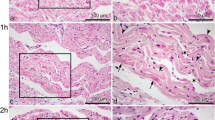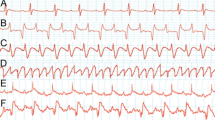Abstract
Purpose
Myocardial infarction (MI) is one of the most prevalent causes of sudden adult death. It is difficult to diagnose early MI postmortem because there are no typical or characteristic changes in morphology. In this study, changes in the level of the mRNA for the urotensin receptor (UR) were investigated postmortem to determine the suitability of UR as a biomarker for diagnosis of early MI after death.
Methods
An MI rat model was developed by injecting rats with isoproterenol (ISO) (lethal dose 850 mg/kg) or normal saline (control group). The hearts of rats in the control and ISO-induced MI groups were harvested at 0, 1, 3, 6, 12, 24, 48, and 72 h (h) postmortem. The hearts were then immediately submerged in 1 mL of RNA stabilization solution and stored at 4 °C for <1 week before RNA extraction. Relative UR expression analysis was performed using the StepOne Plus Real Time PCR System with cDNA synthesized from rat heart.
Results
Postmortem UR mRNA expression was higher in the ISO-induced MI group than in the control group, at both 4 and 20 °C, at all of the time points examined except 72 h postmortem (p < 0.0001). The largest increases were observed at ambient temperature and 6 h postmortem.
Conclusions
Based on our findings, increased postmortem UR expression could serve as a biomarker to aid diagnosis of early MI.


Similar content being viewed by others
References
Adnet F, Renault R, Jabre P, Kulstad E, Galinski M, Lapostolle F. Incidence of acute myocardial infarction resulting in sudden death outside the hospital. Emerg Med J. 2011;28:884–6.
Rodriguez-Calvo MS, Brion M, Allegue C, Concheiro L, Carracedo A. Molecular genetics of sudden cardiac death. Forensic Sci Int. 2008;182:1–12.
Kakimoto Y, Tsuruyama T, Miyao M, Abiru H, Sumiyoshi S, Kotani H, Haga H, Tamaki K. The effectiveness and limitations of triphenyltetrazolium chloride to detect acute myocardial infarction at forensic autopsy. Am J Forensic Med Pathol. 2013;34:242–7.
Perez-Carceles MD, Noguera J, Jimenez JL, Martinez P, Luna A, Osuna E. Diagnostic efficacy of biochemical markers in diagnosis post-mortem of ischaemic heart disease. Forensic Sci Int. 2004;142:1–7.
Batalis NI, Marcus BJ, Papadea CN, Collins KA. The role of postmortem cardiac markers in the diagnosis of acute myocardial infarction. J Forensic Sci. 2010;55:1088–91.
Osuna E, Perez-Carceles MD, Alvarez MV, Noguera J, Luna A. Cardiac troponin I (cTn I) and the postmortem diagnosis of myocardial infarction. Int J Legal Med. 1998;111:173–6.
Bi H, Yang Y, Huang J, Li Y, Ma C, Cong B. Immunohistochemical detection of S100A1 in the postmortem diagnosis of acute myocardial infarction. Diagn Pathol. 2013;8:84.
Bardales RH, Hailey LS, Xie SS, Schaefer RF, Hsu SM. In situ apoptosis assay for the detection of early acute myocardial infarction. Am J Pathol. 1996;149:821–9.
Rodriguez-Calvo MS, Tourret MN, Concheiro L, Munoz JI, Suarez-Penaranda JM. Detection of apoptosis in ischemic heart. Usefulness in the diagnosis of early myocardial injury. Am J Forensic Med Pathol. 2001;22:278–84.
Domenech P, Carbonell L, Perez Carceles MD, Falcon M, Luna A, Osuna E. Application of postmortem lipid peroxidation in heart tissue to the diagnosis of myocardial damage. Int J Legal Med. 2004;118:19–23.
Jasra SK, Badian C, Macri I, Ra P. Recognition of early myocardial infarction by immunohistochemical staining with cardiac troponin-I and complement C9. J Forensic Sci. 2012;57:1595–600.
Leadbeatter S, Wawman HM, Jasani B. Immunocytochemical diagnosis of early myocardial ischaemic/hypoxic damage. Forensic Sci Int. 1989;40:171–80.
Ortmann C, Pfeiffer H, Brinkmann B. A comparative study on the immunohistochemical detection of early myocardial damage. Int J Legal Med. 2000;113:215–20.
Piercecchi-Marti MD, Lepidi H, Leonetti G, Vire O, Cianfarani F, Pellissier JF. Immunostaining by complement C9: a tool for early diagnosis of myocardial infarction and application in forensic medicine. J Forensic Sci. 2001;46:328–34.
Ribeiro-Silva A, Rossi MA, Martin CC. Is immunohistochemistry a useful tool in the postmortem recognition of myocardial hypoxia in human tissue with no morphological evidence of necrosis? Am J Forensic Med Pathol. 2002;23:72–7.
Lewandrowski KB. Cardiac markers of myocardial necrosis: a history and discussion of milestones and emerging new trends. Clin Lab Med. 2014;34:31–41.
Kost GJ, Kirk JD, Omand K. A strategy for the use of cardiac injury markers (troponin I and T, creatine kinase-MB mass and isoforms, and myoglobin) in the diagnosis of acute myocardial infarction. Arch Pathol Lab Med. 1998;122:245–51.
Hansen SH, Rossen K. Evaluation of cardiac troponin I immunoreaction in autopsy hearts: a possible marker of early myocardial infarction. Forensic Sci Int. 1999;99:189–96.
Sapouna R, Gourgiotis D, Athanaselis S, Papadodima S, Spiliopoulou C. Diagnostic value of cardiac troponin I in postmortem diagnosis of myocardial infarction. Am J Forensic Med Pathol. 2013;34:139–41.
Hu BJ, Chen YC, Zhu JZ. Study on the specificity of fibronectin for post-mortem diagnosis of early myocardial infarction. Med Sci Law. 2002;42:195–9.
Lachica E, Villanueva E, Luna A. Comparison of different techniques for the postmortem diagnosis of myocardial infarction. Forensic Sci Int. 1988;38:21–6.
de la Grandmaison GL. Is there progress in the autopsy diagnosis of sudden unexpected death in adults? Forensic Sci Int. 2006;156:138–44.
Langham RG, Kelly DJ, Gow RM, Zhang Y, Dowling JK, Thomson NM, Gilbert RE. Increased expression of urotensin II and urotensin II receptor in human diabetic nephropathy. Am J Kidney Dis. 2004;44:826–31.
Clozel M, Binkert C, Birker-Robaczewska M, Boukhadra C, Ding SS, Fischli W, et al. Pharmacology of the urotensin-II receptor antagonist palosuran (ACT-058362; 1-[2-(4-benzyl-4-hydroxy-piperidin-1-yl)-ethyl]-3-(2-methyl-quinolin-4-yl)-urea sulfate salt): first demonstration of a pathophysiological role of the urotensin System. J Pharmacol Exp Ther. 2004;311:204–12.
Protopopov A, Kashuba V, Podowski R, Gizatullin R, Sonnhammer E, Wahlestedt C, et al. Assignment of the GPR14 gene coding for the G-protein-coupled receptor 14 to human chromosome 17q25.3 by fluorescent in situ hybridization. Cytogenet Cell Genet. 2000;88:312–3.
Ames RS, Sarau HM, Chambers JK, Willette RN, Aiyar NV, Romanic AM, et al. Human urotensin-II is a potent vasoconstrictor and agonist for the orphan receptor GPR14. Nature. 1999;401:282–6.
Zhu YC, Zhu YZ, Moore PK. The role of urotensin II in cardiovascular and renal physiology and diseases. Br J Pharmacol. 2006;148:884–901.
Douglas SA, Tayara L, Ohlstein EH, Halawa N, Giaid A. Congestive heart failure and expression of myocardial urotensin II. Lancet. 2002;359:1990–7.
Khan SQ, Bhandari SS, Quinn P, Davies JE, Ng LL. Urotensin II is raised in acute myocardial infarction and low levels predict risk of adverse clinical outcome in humans. Int J Cardiol. 2007;117:323–8.
Zhang YG, Li J, Li YG, Wei RH. Urotensin II induces phenotypic differentiation, migration, and collagen synthesis of adventitial fibroblasts from rat aorta. J Hypertens. 2008;26:1119–26.
Tzanidis A, Hannan RD, Thomas WG, Onan D, Autelitano DJ, See F, Kelly DJ, Gilbert RE, Krum H. Direct actions of urotensin II on the heart: implications for cardiac fibrosis and hypertrophy. Circ Res. 2003;93:246–53.
Pakala R. Role of urotensin II in atherosclerotic cardiovascular diseases. Cardiovasc Revasc Med. 2008;9:166–78.
Chappel CI, Rona G, Balazs T, Gaudry R. Severe myocardial necrosis produced by isoproterenol in the rat. Arch Int Pharmacodyn Ther. 1959;122:123–8.
Sharma M, Kishore K, Gupta SK, Joshi S, Arya DS. Cardioprotective potential of ocimum sanctum in isoproterenol induced myocardial infarction in rats. Mol Cell Biochem. 2001;225:75–83.
Kralova E, Mokran T, Murin J, Stankovicova T. Electrocardiography in two models of isoproterenol-induced left ventricular remodeling. Physiol Res. 2008;57:83–9.
Ojha S, Goyal S, Sharma C, Arora S, Kumari S, Arya DS. Cardioprotective effect of lycopene against isoproterenol-induced myocardial infarction in rats. Hum Exp Toxicol. 2013;32:492–503.
Mao S, Fu G, Seese RR, Wang ZY. Estimation of PMI depends on the changes in ATP and its degradation products. Legal Med (Tokyo). 2013;15:235–8.
Livak KJ, Schmittgen TD. Analysis of relative gene expression data using real-time quantitative PCR and the 2(-Delta Delta C(T)) Method. Methods. 2001;25:402–8.
Jegou S, Cartier D, Dubessy C, Gonzalez BJ, Chatenet D, Tostivint H, Scalbert E, LePrince J, Vaudry H, Lihrmann I. Localization of the urotensin II receptor in the rat central nervous system. J Comp Neurol. 2006;495:21–36.
Vennemann M, Koppelkamm A. mRNA profiling in forensic genetics I: Possibilities and limitations. Forensic Sci Int. 2010;203:71–5.
Harrison PJ, Heath PR, Eastwood SL, Burnet PWJ, McDonald B, Pearson RCA. The relative importance of premortem acidosis and postmortem interval for human brain gene expression studies: Selective mRNA vulnerability and comparison with their encoded proteins. Neurosci Lett. 1995;200:151–4.
Li JZ, Vawter MP, Walsh DM, Tomita H, Evans SJ, Choudary PV, et al. Systematic changes in gene expression in postmortem human brains associated with tissue pH and terminal medical conditions. Hum Mol Genet. 2004;13:609–16.
Preece P, Cairns NJ. Quantifying mRNA in postmortem human brain: influence of gender, age at death, postmortem interval, brain pH, agonal state and inter-lobe mRNA variance. Mol Brain Res. 2003;118:60–71.
Author information
Authors and Affiliations
Corresponding author
Rights and permissions
About this article
Cite this article
Sener, M.T., Karakus, E., Halici, Z. et al. Can early myocardial infarction-related deaths be diagnosed using postmortem urotensin receptor expression levels?. Forensic Sci Med Pathol 10, 395–400 (2014). https://doi.org/10.1007/s12024-014-9575-2
Accepted:
Published:
Issue Date:
DOI: https://doi.org/10.1007/s12024-014-9575-2




